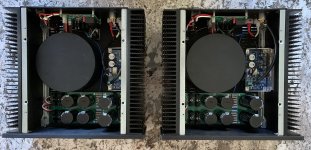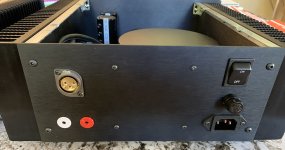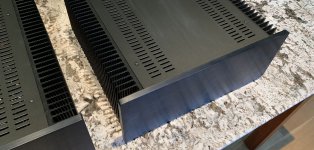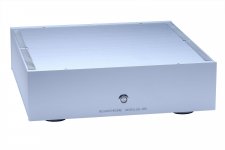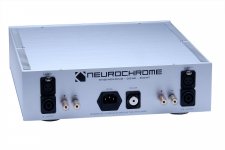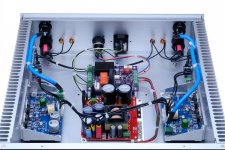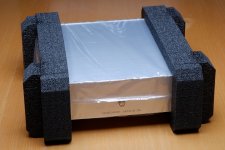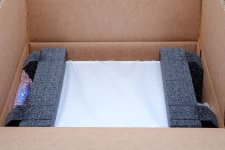Sorry. I've been burning the candle at both ends lately, so I mixed up 10x and 20 dB. Sorry about that.
The Modulus-286 is 20x (26 dB) gain by default.
The Modulus-286 gain can be lowered to 10x (20 dB) by plucking one (surface mounted) resistor.
I currently have one Modulus-286 module in stock with the default 26 dB gain and two Modulus-286 modules with 20 dB (10x) gain.
I apologize for the confusion.
I will have more MOD286 modules made early next year.
Tom
The Modulus-286 is 20x (26 dB) gain by default.
The Modulus-286 gain can be lowered to 10x (20 dB) by plucking one (surface mounted) resistor.
I currently have one Modulus-286 module in stock with the default 26 dB gain and two Modulus-286 modules with 20 dB (10x) gain.
I apologize for the confusion.
I will have more MOD286 modules made early next year.
Tom
Last edited:
I have been offered a unit built from last years 286 kit , but my speakers, nominal impedance rating 8 ohms, dip to 2.6 ohm at 1600hz. Is this likely to cause problems?
I have been offered a unit built from last years 286 kit , but my speakers, nominal impedance rating 8 ohms, dip to 2.6 ohm at 1600hz. Is this likely to cause problems?
Should be fine, that will be 5.2ohms effective for each LM3886 which is easily doable. Stability into a reactive load should be fine and there shouldn't really be a demand for much current with most music at those frequencies.
Neurochrome chipamp for home theatre..
Hi guys - forgive me if this question has been beat to death..
I've been eyeing chipamps for quite a few years - having infact bought supplies to make them probably 8 years ago and not having had the time to do so with the chassis requirements etc while in medical training..
The major thing that has stopped me from more actively pursuing it is that my primary use for these amps would be in a home theatre setup - would need 5 channels for my current setup which is a sizeable investment. Additionally, I have read intermittent discussions regarding clipping related to chipamp setups in sudden high volume scenes in movies such as explosions. Has anybody got experience or some further insight into this? I would really like to build some high quality amplifiers and I don't have a HT setup that gets used at high volumes since I like in an urban home with neighbors above, etc, so I'd expect not to be making use of every ounce of output with the amps. Is the clipping more a function of the input voltage being beyond what the chipamp is designed to accomodate, or is it simply due to the inherent power output limitations of the chipamps?
Any insight or comments would be really appreciated as I'm currently eyeing these neurochrome kits and have been for some time..
Hi guys - forgive me if this question has been beat to death..
I've been eyeing chipamps for quite a few years - having infact bought supplies to make them probably 8 years ago and not having had the time to do so with the chassis requirements etc while in medical training..
The major thing that has stopped me from more actively pursuing it is that my primary use for these amps would be in a home theatre setup - would need 5 channels for my current setup which is a sizeable investment. Additionally, I have read intermittent discussions regarding clipping related to chipamp setups in sudden high volume scenes in movies such as explosions. Has anybody got experience or some further insight into this? I would really like to build some high quality amplifiers and I don't have a HT setup that gets used at high volumes since I like in an urban home with neighbors above, etc, so I'd expect not to be making use of every ounce of output with the amps. Is the clipping more a function of the input voltage being beyond what the chipamp is designed to accomodate, or is it simply due to the inherent power output limitations of the chipamps?
Any insight or comments would be really appreciated as I'm currently eyeing these neurochrome kits and have been for some time..
The Modulus-286 is not your typical chipamp. First off, it uses error correction applied to the output stage to drive the distortion down into the abyss. That's how I get the stellar performance even with a 1990s era chipamp. In addition, the Modulus-286 uses two LM3886es in parallel for higher output current capability, thereby higher output power.
I'm currently using a pair of Linkwitz LXmini speakers and a 4-channel Modulus-86 amp in my "home theatre" (TV + stereo speakers) setup. I have no issue driving the speakers hard enough that the explosions are so loud that I worry my neighbours will hear. I live in a house... 🙂
Tom
I'm currently using a pair of Linkwitz LXmini speakers and a 4-channel Modulus-86 amp in my "home theatre" (TV + stereo speakers) setup. I have no issue driving the speakers hard enough that the explosions are so loud that I worry my neighbours will hear. I live in a house... 🙂
Tom
The Modulus-286 is not your typical chipamp. First off, it uses error correction applied to the output stage to drive the distortion down into the abyss. That's how I get the stellar performance even with a 1990s era chipamp. In addition, the Modulus-286 uses two LM3886es in parallel for higher output current capability, thereby higher output power.
I'm currently using a pair of Linkwitz LXmini speakers and a 4-channel Modulus-86 amp in my "home theatre" (TV + stereo speakers) setup. I have no issue driving the speakers hard enough that the explosions are so loud that I worry my neighbours will hear. I live in a house... 🙂
Tom
Excellent.. how're you controlling the sound level? Are you controlling via the preamp? The other thing that in a HT setup is that I'd prefer not to be using manual dials to adjust volume, and therefore I'd think the most viable solution would be to adjust using the input from a commercial preamp (which would obviously need to be updated periodically as HDMI specs update, etc). However, this would obviously be limiting the input voltage and therefore signal to noise ratio might be compromised?
Also, for rear speakers, would the optimal solution be to run cable from the preamp to the amps located next to the speakers, or would it be better to have the all of the amps side by side, connected into the same power outlet and run a longer cable after the amplifier to the rears? How long of cable runs are okay to be using after the amps without substantial signal loss, distortion, etc?
If you're looking to set up a surround sound system, I suggest you use a preamp with a surround sound processor. That would then provide volume control and split the signal to the different power amps. Then just power each speaker with a Modulus-286.
Tom
Tom
Modulus-286 Monoblocks
I built a set of monoblocks using a fairly beefy power supply in a Modushop Mini-Dissipante 3U (300mm deep) chassis.
I used a inexpensive power supply board I bought on ebay which uses a CRC filter. This board didn't have circuitry for a snubber so this is soldered underneath. I also used an XRKAudio soft start board (mounted vertically on the back panel) which I've used on other projects.
The speaker connectors are GR-Research tube connectors.
I haven't had a chance to listen to them on my primary system yet, but they sound nice on my workshop speakers.
The amp modules came quickly and are very nicely built (thanks Tom). The only thing I'd like to see done a little differently is to use a screw terminal connector for the speaker connections that allowed higher quality cable to be used without having to do my own crimp connections.
I built a set of monoblocks using a fairly beefy power supply in a Modushop Mini-Dissipante 3U (300mm deep) chassis.
I used a inexpensive power supply board I bought on ebay which uses a CRC filter. This board didn't have circuitry for a snubber so this is soldered underneath. I also used an XRKAudio soft start board (mounted vertically on the back panel) which I've used on other projects.
The speaker connectors are GR-Research tube connectors.
I haven't had a chance to listen to them on my primary system yet, but they sound nice on my workshop speakers.
The amp modules came quickly and are very nicely built (thanks Tom). The only thing I'd like to see done a little differently is to use a screw terminal connector for the speaker connections that allowed higher quality cable to be used without having to do my own crimp connections.
Attachments
Very happy with my 86, built by Firebottle,(UK), playing currently into Opera Consonance
M15-24th Anniversary horns.
Looking forwards to hearing it via my (no cross-overs) Ocellia Calliope .21 speakers.
The 86 has more than enough power.
M15-24th Anniversary horns.
Looking forwards to hearing it via my (no cross-overs) Ocellia Calliope .21 speakers.
The 86 has more than enough power.
My latest project: Stereo Modulus-286 with Guardian-86 speaker protection. Powered by the Connex SMPS300REh power supply controlled by my ISS Rev. 2.0 prototype (which will be replaced by the production version once it gets in).
I'm building five of these. One has sold already ($2500).
Tom
I'm building five of these. One has sold already ($2500).
Tom
Attachments
Last edited:
Tom,
Nice unit, congratulations! Is that a natural anodized aluminum, or has a little bit of white anodizing been done?
A question - doesn't the SMPS already have a built-in soft start? Also there is no transformer and large capacitor banks - so would there be strong inrush currents?
Nice unit, congratulations! Is that a natural anodized aluminum, or has a little bit of white anodizing been done?
A question - doesn't the SMPS already have a built-in soft start? Also there is no transformer and large capacitor banks - so would there be strong inrush currents?
Very nice Tom.
What panel connector have you used for the trigger input, it's not from Neutrik is it?
Where is the power lead coming from for the Guardian-86s?
What panel connector have you used for the trigger input, it's not from Neutrik is it?
Where is the power lead coming from for the Guardian-86s?
I thought white anodizing still was not possible yet? Although some cursory research online suggests that with certain parameters, a clear anodize can give a bit of an off-white colour.Tom,
Nice unit, congratulations! Is that a natural anodized aluminum, or has a little bit of white anodizing been done?
Last edited:
Holy, that purple PCB is absolutely killer.controlled by my ISS Rev. 2.0 prototype (which will be replaced by the production version once it gets in).
I'm building five of these. One has sold already ($2500).
Tom
Holy, that purple PCB is absolutely killer.
Yeah. I'm using OSH Park for prototypes now. I've often thought of asking them if their founder went to University of Washington. Huskies are purple and gold. 🙂
The production version of the ISS will be Neurochrome Blue as always.
What panel connector have you used for the trigger input, it's not from Neutrik is it?
Nope. Switchcraft. It's a 3.5 mm stereo jack.
Where is the power lead coming from for the Guardian-86s?
I soldered it directly to the power connector on the MOD286 on the bottom of the PCB.
Nice unit, congratulations! Is that a natural anodized aluminum, or has a little bit of white anodizing been done?
As far as I know it's clear anodized. I think it's the surface finish that gives it a brighter look. It's a very, very light hairline finish. It's smooth to the touch. I really like it.
A question - doesn't the SMPS already have a built-in soft start?
It does. I'm using the ISS mostly as a fancy power switch. I wanted the LED dimmers as the LEDs in the PV6-series power switch are quite bright. I also wanted to support 12 V trigger. Further, the low-voltage control opens up a wide array of options for power switches. So that's why I use the ISS.
Tom
- Home
- Vendor's Bazaar
- Neurochrome Modulus-286: 65W (8Ω); 125W (4Ω) @ <-120dB THD Composite Amplifier Module
